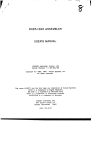Download Chaffoteaux & Maury Britony System 60 Instruction manual
Transcript
cCJ System Plus Duo 55 Installation and Operating Instruction Manual Including User Instructions Chaffoteaux et Maury Ltd., as a leading manufacturer of domestic and commercial water heating appliances, as well as domestic unvented direct and indirect storage cylinders, is committed to providing high quality products and a first class after sales service. If it is necessary to contact an engineer, then telephone your local Chaffoteaux Service Centre. Advice on installation or servicing can also be obtained by contacting the Chaffoteaux Customer Services Department. CUSTOMER SERVICES DEPARTMENT Tel: 01952 222288 / Fax: 01952 224028 LOCAL CHAFFOTEAUX SERVICE CENTRE Tel: 0807 2430224 The manufacturer’s guarantee against faulty manufacture or materials for the cylinder is 5 years and for the electrical components, thermal controls and safety valves is for 12 months, from the date of purchase. The guarantee will be invalidated if the factory fitted temperature and pressure relief valve is tampered with or removed. The Manufacturer or Distributors cannot be held responsible for any damage howsoever caused and which is a consequence of the removal or tampering. The guarantee may also be invalidated if the appliance is not installed by a competent person in accordance with the recommendations made herein, current standards, regulations or in a manner not approved by the manufacturer, modified in any way, subjected to frost, misuse or neglect, and that factory fitted parts have had unauthorised repairs or replacements carried out. Evidence of purchase and the date of supply must be made available at the time of any claim. To assist us in providing you with an efficient after sales service, please return the guarantee registration card enclosed with the cylinderwithout delay. The installation of this appliance must be carried out by a licenced installer and who is a CORGI Registered person or other competent person and in accordance with the requirements of the Gas Safety (Installation and Use) Regulations and the Building Regulation Approved Document G3. In addition, the installation must also comply with the current byelaws of Local Water Undertakings, Building Regulations, IEE Wiring Regulations, Local Authority Building Standards (Scotland) Regulations and the Safety Document 635 The Electricity at work Regulation. part 1, BS 7593, BS 6789, BS 5546, BS 4814, BS 7074 parts 1 and 2, BS 7671 and BG DM2. Precautions: During servicing, keep the dust generation to a minimum and avoid inhaling any dust and contact with the skin and eyes. Normal handling and use will not present any discomfort, although some people with a history of skin complaints may be susceptible to irritation. When disposing of the lining, ensure that it is securely wrapped and wash hands after contact. It should also be carried out in accordance with the current editions of the following British Standards Codes of practice: BS 6981, BS 5440 parts 1 and 2, BS 5449 Installation must be carried out by a suitably qualified installer and in accordance with current regulations and codes of practice. l No valve should be fitted between the expansion relief valve and the storage cylinder. Only the safety valves supplied with the DUO 55 cylinder should be used. The discharge pipe must be terminated where it is visible and will not cause danger to people in the vicinity of the discharge. The DUO 55 cylinder must not be used without the safety valves and expansion vessel. Note: The discharge could consist of scalding water and steam. l The boiler, cylinder and ancillary controls must be adequately maintained. The installation must have a sufficient and constant supply of mains fed cold water. l Only Chaffoteaux approved replacement parts should be used. Customer Care ............................................... .I Guarantee ...................................................... .I Commissioning ........................................ 16-l 7 DHW .................................................................. 16 Central Heating .................................................. 16 Lighting the Boiler.. ............................................. 17 Statutory Requirements .................................. .2 Post Commissioning .................................... Safety Notice .................................................. .2 Contents ......................................................... .3 Specifications ................................................. .4 Britony System Plus 60 ....................................... .4 DUO 55 Cylinder ................................................. .4 Weights ............................................................... .4 Minimum Clearances ........................................... 4 Outer Case Dimensions for Cylinder & Boiler ..... .4 Dimensions .................................................... .5 Location of Components ............................. 6-7 System Guidance .................................... 18-20 Flue .................................................................... Ventilation ........................................................... Gas Supply.. ....................................................... Electrical Supply ................................................. System Pressure ................................................ Flushing & Water Treatment .............................. System Controls ................................................. Bypass & Pump.. ................................................ Expansion Vessel ............................................... Filling Point.. ....................................................... Maintenance.. ............................................... The Cylinder.. ....................................................... 6 Location of Components ...................................... 6 The Safety Controls Pack.. ................................... 7 Introduction .................................................... .8 Operation .................................................... 8-9 Installing the Boiler ....................................... .I0 Planning ............................................................. Location ............................................................. Safety Notice ...................................................... Installation ............................................... e 18 18 18 18 19 19 19 19 20 20 .21 Routine Maintenance ......................................... 21 User’s Instructions.. ................................. 21-22 Switching On ...................................................... Heating ............................................................... Hot Water.. ......................................................... To Turn Boiler Off Completely ............................ Operational Faults ................................... 22 22 22 22 23-24 10 10 10 1O-14 Positioning the Boiler & Cylinder on the Wall.. .... The Boiler.. ......................................................... The Cylinder ........................................................ Making the Electrical Connections ..................... Safety Valves ..................................................... Fitting the Horizontal Flue.. ................................. Refitting the Outer Cases ................................... C&M -.- .I7 10 10 11 13 14 15 15 3 BRITONY SYSTEM PLUS 60 Appliance category .................................... Cat II 2H3+ Heat input C/H & DHW Maximum in kW.. ................................ 20.22 Maximum in Btu/h ............................... 69005 Heat output C/H & DHW Maximum in kW.. ................................ Maximum in Btu/h ............................... C/H circuit pressures Min operating in bar in ib/in* Max operating in bar in ib/in2 Safety discharge in bar.. ................................................. in ib/in3 ................................................ Expansion vessel Pre-charge pressure in bar.. ............... Pre-charge pressure in lb/in2 .............. Net capacity at 3 bar in litre ................ 18 61428 0.7 :p5 36.6 3 43.5 0.7 9.4 5.44 NATURAL GAS G20 Gas rate Maximum in m3/h ................................ 2.14 Maximum in ff/h ................................. 76 Inlet pressure Nominal in mbar ................................. 20 Nominal in in wg ................................. 8 Adjustable by-pass Minimum flow rate in I/h ...................... Minimum flow rate in gal/min .............. Maximum flow rate in I/h ..................... Maximum flow rate in gal/min ............. 100 0.36 700 2.56 Electrical characteristics Supply.. ............................................. 230V - 50Hz Consumption ............................................. Protection ........................................... Fuse no 1 ............................................ Fuse no2 ............................................ External controls ................................. 150W IP 44 2A 1.25A 24V DUO 55 CYLINDER Storage capacity in litre ............................. 55 Max water supply pressure to pressure reducing valve ............................ 12 bar Operating pressure ................................... 3 bar Expansion vessel charge pressure ........... 3 bar Expansion valve setting.. ........................... 6 bar Maximum primary working pressure ......... 3.5 bar Set opening pressure of combined temperature and pressure relief valve.. ..... 90°C ....... 7 bar Heating capacity of the primary heat exchanger ................................................. 23 kW Heating duration (primarytemperature90°C flow @ Im3/hr DHW temperature @ 15°C raised to 65°C in mins) .............................17 min Burner pressure Nominal in mbar ................................. 6.7 Nominal in in wg ................................. 2.7 Consumption per day to maintain the temperature @ 65°C in kWhr/24hr ...... 0.04 70% reheat time ........................................ 13 min Burner injector diameter Natural gas G20 in mm.. ..................... 1.23 WEIGHTS Britony System PROPANE L.P.G. G31 Gas rate Maximum in kg/h ................................ 1.55 Maximum in fRh ................................. 3.42 Inlet pressure Nominal in mbar ................................. 37 Nominal in in wg ................................. 14.8 Burner pressure Nominal in mbar ................................. 21 .O Nominal in in wg ................................. 8.4 BUTANE L.P.G. G30 Gas rate Maximum in kg/h ................................ Maximum in Lbs/h .............................. Inlet pressure Nominal mbar ..................................... Nominal in in wg ................................. 1.58 3.48 28 11.2 Burner pressure Nominal in mbar ................................. Nominal in in wg ................................. Burner injector diameter LPG G30 and G31 in mm ................... 0.70 4 Plus 60 With packaging.. ........................................ 43.2 kg Without packaging.. ................................... 41.2 kg Lift weight .................................................. 35.2 kg Cylinder Weight when empty.. ................................. 33 kg Weight when full ........................................ 90 kg MINIMUM CLEARANCES Both sides ................................................. Above casing ............................................. Below casing ............................................. Front (for servicing) ................................... Front (in operation) .................................... OUTER CASE DIMENSIONS BOILER 5 mm 170 mm 200 mm 500 mm 5 mm FOR CYLINDER Width ......................................................... (minimum space required 450) Height.. ...................................................... Depth.. ....................................................... Minimum space required when cylinder and boiler fitted side by side ...................... 440 850 380 895 & , , , , , , , , , , , , , , , , , , , , , , , , , , , , , , , , , , , , , , J K L N 0 3 : i Ir 67 j I - I I I I I I I I I I I I I I -+--I I -8 +380+ Heating flow H.W. flow Gas supply Heating return Pressure relief outlet TypeClZorC42 e b ~~+~ 022mm 022mm 022mm 022mm I I 015mm The boiler is suitable for the 4 flue types: *type Cl2 or C42 C&M -.- 445 Type C 32 xx l type C32 xx or C32 xy Type C 32 xy 5 The Cylinder The Chaffoteaux et Maury BRITONY DUO 55 is designed for use as an unvented storage cylinder heated indirectly by a BRITONY SYSTEM PLUS 60 boiler. The cylinder is supplied with a safety controls pack and expansion vessel to allow it to be connected to the main cold water supply. The cylinder is stainless steel with a high power coil. It is contained within a white case insulated with a preformed polystyrene jacket. Location of components 1. 2. 3. 4. 5. Air pressure switch Steel chassis complete with expansion vessel Main heat exchanger Combustion chamber Multi-gas burner assembly comprising ignition and ionisation electrodes 6. Automatic air separator and automatic vent 7. Heating circuit flow switch 8. Pump 9. Electrical box 11. Overheat thermostat 12. Gas valve assembly 13. Sealed chamber 14. Flue hood with fan 16. Primary circuit control thermistor 17. Three way valve 18. CH Flow isolating valve 19. Two position selector switch 20. User’s instruction panel 21. Heating flow temperature adjustment 22. Green indicator - Power ON 23. Orange indicator - Burner ON 24. Red indicator - Lock out / flame failure 25. Reset button 26. Pressure gauge 27. Gas service tap 28. Hot water flow isolating valve 29. CH Return isolating valve 30. Pressure relief valve (boiler) 32. By pass 33. By pass adjustment screw 34. Location of central heating filter 35. Expansion relief valve also used for draining cylinder 36. Pressure reducing valve 37. Discharge pipe to tundish 38. Cold water inlet 39. Return to boiler 40. Hot water outlet 41. Cylinder thermostat phial position 42. Flow to coil .6 ,7 8 27 6 29 30 m -- 44. Temperature selector Flow and Return flexible pipes (not visible) 45. Temperature and pressure relief valve 46. Chassis 47. DHW expansion vessel 48. Cylinder 49. Pressure test point The Safety Controls 19 21 20 22 26 Pack To enable the cylinder to comply with the current regulations it is supplied with a safety controls pack. This comprises: Pressure regulator with integral strainer to ensure a constant pressure to the hot water system 44 (non return valve) to prevent the back feeding of hot water to the cold main. Check valve vessel to take up the expansion of the water Expansion when it is heated. Expansion relief valve to prevent over expansion of the water in the system (also used as drain-off for cylinder). Pressure relief valve to prevent over pressurisation of the system. relief valve to provide a safety outlet in Temperature the event of overheating. Cylinder thermostat 18 28 27 33 29 to control the temperature of water in the cylinder. to collect and provide an air break for the discharge pipes from the temperature and pressure relief valves. The discharge must be terminated in a safe and visible location. Tundish 42 48 - 40 39 38 37 C 36 View from underneath cylinder e C&M -.- 7 The Chaffoteaux et Maury BRITONY DUO 55 is a combination of an unvented stainless steel storage cylinder heated indirectly by a fanned flued sealed system boiler within matching outer cases. It benefits from the high efficiency provided by the modern low water content BRITONY System Plus 60 boiler and a high power coil within the cylinder. A combination providing very fast reheating of the hot water. For greater flexibility of installation, the cylinder could be fitted below, on the right or the left of the boiler or separately from the boiler. Supplied directly from the main water supply the cylinder does not need a separate feed cistern or vent pipe in the loft space. The BRITONY DUO 55 provides central heating as well as hot water. The boiler is designed for sealed systems only and a circulating pump, diverter valve, expansion vessel, a pressure gauge and safety valve are included within the boiler. with an expansion vessel, pressure reducer, strainer, check valve, temperature and pressure relief valve, expansion relief valve. The cylinder has been tested and approved by the WRc as meeting with the requirements of EN 60335 2.21 and EN 60529. The boiler has been tested and approved to carry the CE mark. The BRITONY DUO 55 can be installed with the standard horizontal flue, raised horizontal, concentric vertical, twin pipe or SE duct flue arrangements. Adapters, bends and other accessories are available on request. The 1. 2. 3. 4. The cylinder has a capacity of 55 litres and provides the advantages of mains pressure and greater volumes of hot water to taps and showers. It is supplied complete Domestic Hot Water Mode To be able to supply hot water, the selector switch (19 Fig. 1) must be in either in* or ‘1111 2 position. This will confirmed by the green Indicator light 0 (22 Fig. 1). DUO 55 is packed in four cartons: The boiler The flue assembly and fixing kit The cylinder with the safety controls pack, fitting template and instructions manual Connections and plinth to close couple the boiler and cylinder. The boiler will now stay in the hot water mode for three minutes (this can be set to 30 seconds if required. See Commissioning section). Priority will be given to a demand for reheating the cylinder. The hot water temperature in the cylinder can be adjusted between 50°C and 70°C using the control knob on the control panel of the cylinder (44 Fig. 2). When the cylinder thermostat is calling for heat, it switches the 3-way valve (17 Fig. 3) to the hot water position. The hot water from the primary circuit is then diverted through the cylinder coil to heat DHW. 25 The first stage solenoid (12a Fig. 3) and safety solenoid (12~ Fig. 3) open together to allow gas to the burner. The ignition sequence begins and a continuous high speed spark ignites the gas. As soon as a flame is detected the orange indicator bulb& (23 Fig. 1) will light and the second stage solenoid (12b Fig. 3) opens to allow the full gas rate. 19 21 22 Fig. 1 If a flame is not detected, after eight seconds, the security solenoid closes and shuts off the gas. The red lockout indicator bulbjft (24 Fig. 1) will light. Press the RESET button to attempt to relight. The hot water flow temperature is controlled by the primary circuit control thermistor (16 Fig. 3). When the cylinder thermostat is satisfied, the burner is extinguished and the pump stops. 44 Fig. 2 26 Central Heating Mode To be able to supply central heating, the selector switch (19 Fig. 1) must be in ‘~~~~ 3 position. This will be confirmed by the green indicator light 0 (22 Fig. 1). When there is a demand for heating (either from the room thermostat or the external programmer) and the boiler temperature control is calling for heat. The pump starts and at a flow rate of 4ltr/min the central heating flow switch operates allowing the ignition sequence to begin. The first stage solenoid (12a Fig. 3) and safety solenoid (12~ Fig. 3) open together to allow gas to the burner. The ignition sequence begins and a continuous high speed spark ignites the gas. As soon as a flame is detected the orange indicator bulb 0 (23 Fig. 1) will light. After 45 seconds the second stage solenoid (12b Fig. 3) opens to allow the full gas rate. If a flame is not detected, after eight seconds, the security solenoid closes and shuts off the gas. The red lockout indicator bulb f (24 Fig. 1) will light. Press the RESET button to attempt to relight. I& 11 -------4 17 The central heating flow temperature is controlled by the central heating control thermistor (16 Fig. 3). The boiler has been designed to minimise cycling and will not attempt to relight for at least 3 minutes after the boiler thermostat has been satisfied (this can be set to 30 seconds if required, see maintenance and service guide). When the room thermostat is satisfied the burner will switch off and the pump will remain running for a further 3 minutes. 27 Fig. 3 Note: It is possible to override the 3 minute delay by pressing the RESET button (25 Fig. 1). e C&M -.- 9 Planning Safety Notice Installation must be carried out by a suitably qualified installer and in accordance with current regulations and codes of practice. Please ensure that you are familiar with the installation requirements as well as the relevant British Standards and Statutory Regulations (see page 2) before commencing work. Only the safety valves supplied with the cylinder should be used. Location The DUO 55 can be installed on any suitable internal wall. Provision must be made to allow the correct routing of the flue and siting of the terminal to allow the safe and efficient removal of the flue products. The appliance may be installed in any room, although reference must be made to the IEE regulations if it contains a bath or shower. A compartment or cupboard may be used provided that it has been purpose-built or modified for the purpose. It is not necessary to provided permanent Detailed ventilation for cooling purposes. recommendations are given in BS 5440 pt. 2. If it is proposed that it is installed in a timber framed building then reference must be made to British Gas Document DM2, or advice sought from CORGI. The cylinder must not be used without the safety valves and expansion vessel. The boiler, cylinder and ancillary controls must be adequately maintained. The installation must have a sufficient and constant supply of mains fed cold water. No valve should be fitted between the expansion relief valve and the storage cylinder. The discharge pipe must be terminated where it is visible and will not cause danger to people in the vicinity of the discharge. Note: The discharge could consist of scalding water and steam. l The installation kit comprises four cartons: 1. The Boiler Installation and Maintenance Instructions (for the boiler only) Accessory bag 1 t Safety valve discharge elbow t Silicone tube t Washers for connecting tails: (2 x 22mm, 2 x 15mm, 1 x gas washer) Accessory bag 2 + Flue gasket and 4 x securing bolts l Only Chaffoteaux approved replacement parts should be used. l l l l Water filter and washers: (4 x 22mm, 1 x gas washer) Paper template for the boiler only (showing the dimensions of the boiler and the required 5mm clearance on either side) 4. The Cylinder Installation Pack Paper template showing the fixing positions for the boiler and cylinder Flexible connecting pipes Tundish Thermostat clip and ‘0’ ring Tee l l l l l 2. The Cylinder Installation and Maintenance Instructions (cylinder and boiler) l 3. The Horizontal Flue Starter Pack Pre-piping fixing jig Hanging bracket Connecting tails for the boiler Flue turret 600mm flue pipe including terminal Inner flue Rubber seal Fixing screws and wallplugs Flue restrictor ring l l l l l Positioning Wall the Boiler and Cylinder on the Before commencing installation, decide if the cylinder is to be fitted to the right or left of the boiler. If it is to be fitted beneath the boiler an additional pipe kit will be required, OR the connections to the boiler can be made in copper pipe by using the pre-piping kit supplied with the flue starterpack. l l l l The Boiler The template provides the fixing positions of the boiler and the cylinder when fitted to the right of the boiler or to the left of the boiler. It can also be used to ensure the correct spacing of kitchen cabinets etc. The template is fixed to the wall and used to locate the fixing holes for the boiler hanging bracket, the pre-piping bracket and the cylinder chassis. It should also be used to locate the centre of the flue hole. There is space to allow pipes to pass behind the boiler without the need for an additional spacer. Fig. 4 Drill and plug the wall and secure the hanging bracket using the screws provided. Remove the boiler from its packaging as shown in Fig.4 and remove the outer case as shown in Fig. 5. Hang the boiler on the bracket. Note: If the pre-piping bracket has been used, it must be removed before attempting to hang the boiler. Connecting the Boiler to the System To gain access to the valve connections, press tab (P Fig. 6) to release the catch on either side of the boiler and pivot the electrical box forward. 3 x fibre washers for the cylinder flow, the C/H flow and return connections. Fig. 5 1 x rubber washer ‘R’ is for the gas connection. Before making the connections to the boiler all the system valves should be opened and the pipework thoroughly flushed through with cold water to remove any loose debris. Using Fig 7 for reference, connect the gas and water pipes to the valves using the tails and gaskets provided with the flue starter pack and the cylinder. ij” There is 190mm space, between the valves on the boiler and the wall, to make these connections. Provision must be made to fill and recharge the system pressure. This can be achieved using a filling loop or other methods approved by the Local Water Authority. Fig. 6 The Cylinder The four fixing holes should have been pre-drilled while the paper template was in position. The cylinder must be unpacked and the outer case removed as shown in Fig. 5. The cylinder can now be lifted off the chassis. To gain access to the fixing holes on the chassis, disconnect and remove the expansion vessel by releasing and removing both the locking nut and retaining nut at the inlet. See Fig. 8, position A. The chassis can now be offered up to its position on the wall and secured by the screws provided. The expansion vessel and the cylinder can now be remounted. Fig. 7 e C&M -.- 11 Locate the thermostat phial in its sleeve using the clip and rubber plug supplied. See Fig. 8. Connecting the Cylinder The main water supply should be carefully flushed through, to clear any debris, before connecting to the cylinder. For cylinders fitted to the right of the boiler Connect the long flexible tube (A Fig. 10) between the hot water isolating valve (32 Fig. 10) and the inlet of the coil (42 Fig. 10) using the tail (D Fig. 10). The short flexible pipe (B) is connected between the outlet of the coil (39 Fig. 10) and the central heating return pipe using the tee supplied which must be soldered on to the return tail (C Fig. 10). Connect the cold water supply (EF) to the combination safety valve (G Fig. 10) using the short tail. Use the long tail to connect the hot water outlet (EC). For cylinders fitted to the left of the boiler Connect the short flexible pipe (B) between the hot water flow isolating valve (32 Fig. 11) and the inlet of the coil (42 Fig. 11) using tail (D Fig. 11). The long flexible pipe (A Fig. 11) should be connected between the outlet of the coil (39 Fig. 11) and the central heating return using the tee, which must be soldered onto the return tail (35 Fig. 11). Connect the cold water supply (EF) to the combination safety valve (G Fig. 11) using the short tail. Use the long tail to connect to the hot water outlet (EC). Fig. 9 Fig. 10 Fig. 8 d Fig. 11 Wiring Making the electrical connections To gain access to the electrical connections, press tabs (P Fig 12) to release the catches on either side of the boiler and pivot the electrical box forward. Remove the two retaining screws (Afig 12), lift the cover and turn over to reveal an interface PCB and connecting block (Fig 13). Connect the live and neutral wires to the connector (D Fig 13) on the interface PCB leaving sufficient earth wire to connect to the main earthing point. The connecting cable for the cylinder thermostat is coiled behind the temperature adjuster on the cylinder. This cable is led through the cable clamp on the boiler electrical box and is connected to connecting block (D) as shown in Fig 13. Fig. 12 If a room thermostat is to be fitted, the link wire on the main connector plug (C Fig 13) must be removed and the room thermostat connected in its place. These connections are for use with voltage free switching. /Connections Ra Fig. 13 e C&M -.- 13 Discharge pipe from temperature and pressure relief valve to tundish Safety Valves The DUO 55 has a pressure relief valve fitted to the boiler and a temperature and pressure relief valve fitted to the cylinder. It is most important that they are terminated below the boiler and over the tundish which in turn should terminate safely outside the premises (see Fig. 14). It is recommended that the tundish is installed directly below the discharge pipe from the temperature and pressure relief valve (37 Fig. 15). If necessary, the pressure relief discharge pipe from the boiler may also terminate over this tundish (Fig. 14a). Safety device e.g. ;- Fixed grating Discharge pipe from tundish with continuous fall Fig. 14 3 Valve outlet size Gll2 Minimum size of discharge pipe 15mm Minimum size of discharge pipe from tundish Maximum resistance allowed, expressed as a length of straight pipe (i.e. no elbows or bends) Resistance created by each elbow or bend 22mm Up to 9m 0.8m 28mm Up to 18m l.Om 35mm Up to 27m 1.4m From boiler pressure dzLP--: relief valve and pressure relief valve ; : :’ ‘: ~ iL =: Fig. 14a Fitting the Horizontal Flue The standard horizontal flue kit is suitable for lengths from 300mm up to 610mm. With extensions, the maximum length is 3m. For rear flueing, the standard pack will accommodate a maximum wall thickness of 490mm and for side flueing a maximum wall thickness of 477mm. This takes into account the minimum side clearance of 5mm. The paper template will provide the position for the centre for drilling the flue hole with a core drill. If the flue is a side exit installation, calculate the position of the hole by drawing a line from the centre position on the template to the corner of the wall (sloping downwards away from the boiler at 5mm per IOOOmm). Then measure horizontally 212mm. This will be the centre position of the flue hole. For greater detail please refer to the instructions enclosed with the flue kit. The instructions for fitting the raised horizontal, vertical concentric, twin pipe and SE duct flue options can be found in the relevant flue starter packs. Refitting Fig. 15 37 the Outer Cases The outer cases of the boiler and cylinder can now be refitted. Before fully tightening the retaining screws, the plinths can be placed in position using the keyhole slots and then the screws tightened to hold the case and the plinths in place. Please Note: The cutaway sides of the plinth are to be placed together (Fig. 16) so that the connecting pipework and wiring may be hidden behind the plinth. Fig. 16 e C&M -.- 15 DHW Filling the Cylinder Ensure that all fittings and valves are correctly installed and are water tight Flush all debris from the supply pipes before connecting to the cylinder Open the furthest hot water tap from the DUO 55 cylinder Open the mains water inlet valve and allow the cylinder to fill. Allow water to flow from the tap for a few minutes to ensure any installation debris is flushed through the system Open all other taps in turn to purge any remaining air from the system Check all connections for leaks l l l l l l Fig. 17 Check the operation of the safety valves Manually open the temperature and pressure relief valve (39 Fig. 17) for a few seconds. Check that the water flows away through the tundish and discharge pipework and does not overflow. Ensure that the flow of water has stopped and that the valve has reseated itself. Repeat the above check for the expansion relief valve. l l l l Central l l l l l l l l l l l l Heating Open flow and return valves on the boiler (28 & 29 Fig. 18) Open the automatic air vent (20 Fig. 19) Fill system and vent radiators Set system pressure and remove filling loop Check for leaks Manually check pump is free to turn Switch on electrical supply Turn selector switch (19 Fig. 20) to heating and hot water position Allow pump to run for several minutes. Isolate electrical supply. Drain boiler and check water filter (34 Fig. 19) for installation debris. Replace filter and recharge system. 1% 28 27 29 Fig. 18 Indirect Heating Ensure that the cylinder heating coils are filled and purged of air. l Fig. 19 16 m -- Lighting . . . . . . . . . . . . . the Boiler Connect gas pressure gauge to set test point (43 Fig. 19). Turn on the gas supply and boiler gas tap (27 Fig. 18). Check all boiler connections for gas soundness. Ensure electrical supply is on. Ensure all external controls are calling for heat. Turn selector switch (19 Fig. 20) to heating and hot water position Turn the boiler thermostat to maximum (21 Fig.20). The boiler will light. Allow the boiler to heat system. Check that the inlet gas pressure (working pressure) while the boiler is operating. (Refer to technical data). Check the operation of the boiler controls and safety devices. (See separate servicing leaflet for details). Re-flush the system to remove any dissolved oils and fluxes. Recharge system pressure and introduce any water treatment as required. 49 \ Fig. 20 Handing l l l l l l l Explain to the customer: 1. the operation of the appliance and safety controls 2. things to look out for such as continual leak of water noticed at the tundish 3. Explain the necessity of annual maintenance by a competent person 4. what to do in an emergency Leave users instructions, installation manual and all other documentation with the householder. Fill out and register the guarantee card and send it back to Chaffoteaux et Maury e C&M -.- Over to the Householder Ensure system pressure has been set correctly. Set the boiler and cylinder thermostat and controls. Demonstrate the lighting and operation of the boiler. Demonstrate how to maintain the system pressure. 17 Flue The boiler must be installed so that the flue terminal is exposed to the free passage of external air at all times. It must not be allowed to discharge into another room or space such as an outhouse or closed lean-to. The minimum acceptable clearances are shown below: A Directly below an opening, window etc. 300 mm 75 mm B Below gutters soils pipes or drain pipes C Below eaves 200 mm D Below balconies or car port roof 200 mm E From a vertical drain pipe or soil pipe 75 mm F From an internal or external corner 150 mm G Above ground roof or balcony level 300 mm H From a surface facing the terminal 600 mm I From another terminal facing the terminal 600 mm J From an opening into the dwelling when 1200 mm under a car port K Vertically from a terminal on the same wall 1500 mm L Horizontally from a terminal on the same wall 300 mm M Fixed by the flat roof ubbink rolux 4GM flue terminal N Fixed by a pithed roof ubbink rolux 4GM flue terminal It may be necessary to protect the terminal with a guard if it is accessible and could be damaged. Reference should be made to the Building Regulations for guidance. Suitable guards may be obtained from your local merchant. Ventilation The room in which the boiler is installed does not require specific ventilation. If it is installed in a cupboard or compartment permanent ventilation is not required for cooling purposes. Gas Supply The gas installation and soundness testing must be in accordance with the requirements of BS 6891. The boiler requires a 22mm supply. Ensure that the pipe size is adequate for the demand including other gas appliances on the same supply. Electrical Supply The appliance requires an earthed 230V - 50Hz supply and must be in accordance with current I.E.E. It must also be possible to be able to completely isolate the appliance electrically. Connection should be via a 3 amp fused double pole isolating switch with contact separation of at least 3mm on both poles. Alternatively, a fused 3 amp / 3 pin plug and unswitched socket may be used, provided it is not used in a room containing a bath or shower. It should only supply the appliance. 18 T M I Fig. 21 System Pressure The boiler is suitable for sealed systems only. The maximum working pressure for the appliance is 3 bar. All fittings and pipework connected to the appliance should be of the same standard. Flushing and Water Treatment The performance of the appliance could be impaired by system debris or the effects of corrosion. The system must be flushed thoroughly to remove metal filings, solder, machining oils and other fluxes and greases before connecting the boiler. An appropriate flushing and descaling agent should be used, particularly if it is an existing system. Refer to BS 7593 (1992) for guidance). For more information on the use of corrosion inhibitors, flushing and descaling agents, advice can be sought from the manufacturers of water treatment products such as: Betz Dearbon Ltd Foundry Lane Widnes Cheshire WA8 8UD Tel: 0151 424 5351 Fernox-Fry Technology UK Tandem House Marlowe Way Beddington Farm Lane Croydon, Surrey CR0 4XS Tel: 01799 550811 System Controls The boiler is electronically controlled and is suitable for most modern electronic time and temperature controls. The addition of such external controls can be beneficial to the efficient operation of the system. The boiler connections for external controls are 24V and so only controls of 24Vor that have voltage free contacts should be used. They must not be connected to a 23OV supply. By pass and Pump The boiler is fitted with a pre-adjusted by pass. Although adjustment is not normally necessary, the by pass can e C&M -.- 19 be reset by turning a screw (D Fig. 22) anti-clockwise to open the by-pass using the chart below for guidance. If used on a system with thermostatic radiator valves, the flow rate with thermostatic valves closed should be adjusted to at least 100 Vhr. The chart below indicates the residual head of the pump available for the system. Expansion Vessels Boiler The expansion vessel is pre-charged to 0.7 bar (lOlb/it-?). The vessel is suitable for systems up to 145 litres capacity. For systems of greater capacity an additional expansion vessel will be required. Refer to the chart below and BS 7074 pt. 1 or BS 5449. Cylinder The domestic hot water expansion vessel is pre-charged to 3 bar (45.51b/in2). Fig. 22 Head and flow rate available m H,O I <- Minimum flow rate The vessel is suitable for the 55 litre of water in the cylinder. Filling Point Provision must be made to be able to charge the system on commissioning and to make up any subsequent pressure loss. The method of connection must utilise approved equipment and must comply with the water regulations. A filling loop can be so installed as to be hidden beneath the boiler. 0 100 200 300 400 500 600 700 800 l/h 90010001100 Fig. 23 System Capacity Chart Pressure zo 199 13 I,7 1,6 13 1,4 1,3 12 l,l 1s ‘J,Q 03 0,7 20 40 60 80 100 120 140 160 180 200 220 240 260 Litres Fig. 24 In order to ensure that the BRITONY DUO 55 continues to operate efficiently and safely, it is essential that the boiler and the cylinder are maintained annually. Servicing and repairs should only be carried out by a competent engineer Any part replaced should be genuine Chaffoteaux et Maury spare parts l l Routine l Maintenance 7. Strainer While the cylinder is partially drained the strainer can be removed and cleaned Refill and repressurise the system as set out in the commissioning instructions. 3. Safety Valves Manually operate the temperature, pressure and expansion relief valves. Check that water runs freely through the tundish and that the discharge point without overflowing. . Check that the flow of water stops and that the valves reseat satisfactorily. . For details on boiler maintenance, refer to the separate Britony System Plus Maintenance and Servicing Instructions. 2. Expansion Vessel While there is no pressure in the system the pressure in the expansion vessel can be checked against the pressure on the data badge. l Except for the temperature adjuster (44 Fig. 26), there are no user adjustable controls on the DUO. Any adjustments or maintenance must be carried out by a suitably qualified engineer, installer or electrician. If water is seen discharging from the DUO safety valves, turn off the boiler. Do not turn off the water supply. Contact the installer or other suitably qualified engineer. Ensure that the appliance is serviced and inspected at least annually. 19. Two position Selector switch 0 = Switched OFF Fig. 25 ‘1111= Central heating 20. User’s instruction panel. 21. ‘1111 Heating flow temperature adjustment 22. 0 Green indicator - Power ON 23. 0 Orange indicator - Burner ON 24. liil Red indicator - Lock out/flame failure 25. ‘RESET’ Reset button 26. 0 Pressure gauge Isolating 18. 27. 29. 21 22 Taps CH Flow isolating valve Gas service tap CH Return isolating valve Cylinder 44. 19 Control Panel Temperature control 26 I I’ I 44 Fig. 26 e -.- C&M 21 Switching On 1. Check that the gas service tap is opened at the gasmeter and main power is on. 2. Check that pressure in central heating system is above 0.7 bar and below 2.5 bar with the pressure gauge @ (26). 3. Open the gas tap (27) by turning from right to left.& 4. The boiler is now ready to use. Heating 1. Turn selector switch (19) fully clockwise to position ‘1111 The green ‘power on’ indicator (‘J will light. 2. If the room thermostat (if fitted), the boiler temperature control ‘~~~~and the clock (if fitted) are all calling for heat, the orange ‘burner on’ indicator @ will light and the heating will be on. Note: If the boiler has been turned off for some time the first attempt to light it may result in a lockout j& . If this happens press the reset button (25) and the boiler will light. Hot Water Turn selector switch (19) clockwise from the ‘off position to the first setting (hot water only) 2 or the second setting (heating and hot water) ‘1111 /x\c . The green indicator 8 will light. Turn the temperature selector on the cylinder fascia panel (44) to the desired position. If the cylinder thermostat is calling for heat, the orange ‘burner on’ indicator 0 will light and the water in the cylinder will begin to heat up. To Turn Boiler Off Completely 1. Turn the selector switch (19) to the off position l 2. Turn the gas tap (27) from left to right STOP’. I Deterioration flow or pressure at hot tap I 1 I Cold water from hot taps I I 1 Remove and clean c Check operation of Boiler 3 port valve 1 I + Boiler not operating 4 Reset and check operation of cylinder thermostat L I I”” Ei8 I Discharge of Water from the Expansion Relief Valve Chaffoteaux et Maury are contunuously improving their products and therefore reserve the right to change specifications without prior notice and accepts no liability for any errors or omission in the information contained in this document. 0 Chaffoteaux & Maury Limited 1999 Chaffoteaux & Maury Limited, Trench Lock, Trench, Telford, Shropshire TFI 4SZ. Telephone: 01952 222727 / Facsimile: 01952 243493 Technical Helpline: 01952 222288 /Technical Fax: 01952 224028 I In Warranty Service: 0807 2430224




























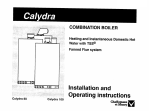
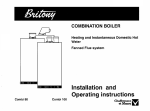

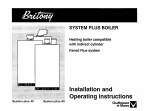
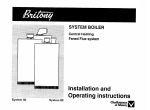
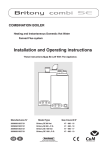
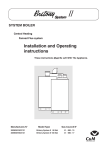
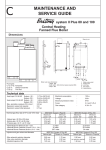
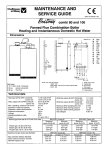
![Maximum Model service Manual.ppt [호환 모드]](http://vs1.manualzilla.com/store/data/006002079_1-f9e925e4876feffe85b493d91263fd66-150x150.png)
